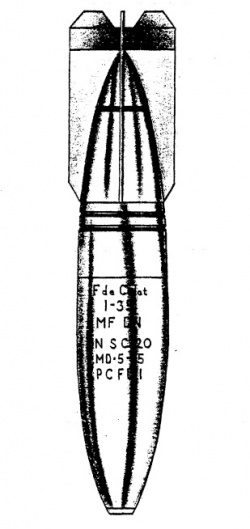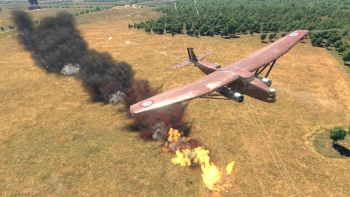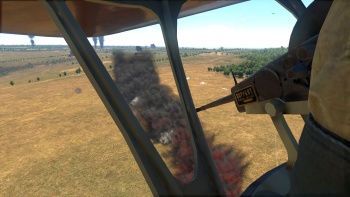G.A. MMN. 50 (50 kg)
Contents
Description
The G.A. MMN. 50 (50 kg) is a 50 kg bomb which was constructed out of welded rolled sheet steel; it has either a longitudinal or a circumferential weld[1]. The overall color of the bomb is yellow and typically had the type of explosive filling and words "F de Culot" (F of Base or Fuse in Base) painted on the bomb casing.
| Data for G.A. MMN. 50 (50 kg) | ||
|---|---|---|
| Overall Length | 118 cm | 46.5 in |
| Body Diameter | 19.9 cm | 7.85 in |
| Fuse Type | M. No.2 | Tail mount |
| Filling | (Fr) M.Mn | (USA) Trimonite |
| Filling Weight | 28.6 kg | 63 lb |
| Total Weight | 50 kg | 112 lb |
Vehicles equipped with this weapon
General info
Effective damage
The G.A. MMN. 50 (50 kg) is filled with Mélinite-Mononitro-nitronaphtaline (M.Mn)[2] or Trimonite (70% Melinite - Picric Acid and 30% Mononitionapthalene). These are typically general purpose/anti-personnel bombs with a Picric acid burster[3] charge.
Comparison with analogues
Give a comparative description of bombs which have firepower equal to these type of weapons.
Usage in the battles
Due to the small size of the G.A. MMN. 50 (50 kg), it is not advisable to drop just one at a time. Many of the French bombers can carry between 16 and 55 of these bombs and can cause more damage when dropped en masse over an area also know as "carpet bombing." The lower altitude you drop the bombs from, the less time enemy vehicles (including AI drivers) have to avoid the in-bound bombs. These bombs are effective against:
- AA vehicles
- AAA cannons (non pill-box)
- Enemy aircraft landing or parked on a runway
- Clustered or columns of vehicles
Pros and cons
Pros:
- Effectively used for carpet bombing lightly or no armored targets
- Large payload aircraft like F.222.2 and N.C.223.3 can take out columns of AA vehicles in one pass
Cons:
- Less effective against armored vehicles, reinforced pillboxes and bases
- Hard to concentrate large amounts of damage with small bombs
History
Examine the history of the creation and combat usage of this weapon. If the historical reference turns out to be big one, take it into a separate article and add a link to it by using the "main" template. In the end be sure to include references to sources.
Media
An excellent addition to the article would be a video guide, as well as screenshots from the game and photos.
Read also
Links to the articles on the War Thunder Wiki that you think will be useful for the reader, for example,
- reference to the article about the variant of the cannon/machine gun;
- references to approximate analogues by other nations and research trees.
ETC.
Sources
Paste links to sources and external resources, such as:
- topic on the official game forum
- page on the Wikipedia
- page on aircraft or ground forces encyclopedia
- other literature
- ↑ NAVORD OP 1668 - Italian and French Explosive Ordnance - Naval Ordnance Systems Command, June 1946, p. 180
- ↑ FTC 381-5042 Handbook of Foreign Explosives - U.S. Army Foreign Science and Technology Center, October 1965, p. 226
- ↑ FTC 381-5042 Handbook of Foreign Explosives - U.S. Army Foreign Science and Technology Center, October 1965, p. 120






